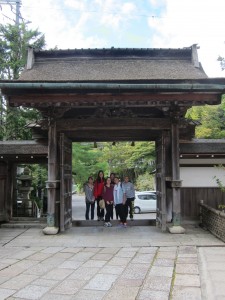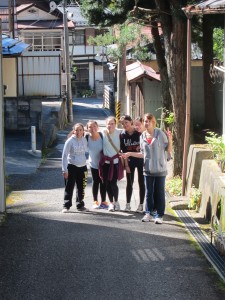Six students and I left the gates of Rengejô’in this morning just before 9 am, headed up to Nyonindo – a shrine at the women’s hall. Until the late 19th century, women were not permitted on Mt. Koya (much like Mt. Athos today), and so would climb up to these women’s halls to wait to see sons (and husbands) who had gone to Koyasan. There were seven gates to Koya, and a hall at each gate, only this one survives. From there we walked the Nyonimichi, the women’s trail that rings Koyasan, connected the sites of the seven halls.
The trail can be a bit tough to follow (trail signs are in kanji for the most part), but after one false start we hiked 3 km of the 7 km trail. The light through the cedars was beautiful, it’s the first sunny day we’ve had since Kyoto. In places the trail clings tenuously to the edge of the mountain, and you are left with a physical sense of what “marginalized” might mean. It was steep, with lots of spider webs, including one that functioned as a diffraction grating, splitting the light into all the colors of the spectrum.
We turned off the trail at a small shrine and walked down a side street, stopping at one of the ubiquitous vending machines for something cold to drink (the challenge is figuring out what might be to your taste).
From there, we walked to Kongobuji, the head temple of the Shingon Buddhist sect. The old monastery kitchen is amazing, with pots for cooking rice that are large enough to take a bath in, and rice paddles to match. The temple has the largest dry stone garden in Japan, and a selection of beautiful painted screens. We toured the temple and garden, where Katia reminded us that Taka-san, the vice abbot at Shunko-in, had told us that these gardens are best viewed from a seated position within the hall, rather than standing on the veranda. To my eye at least, the gardens gain a depth from that perspective, reminiscent of a 19th century landscape painting.
We enjoyed tea in the temple, with a sweet rice cookie and the puffed rice that Michelle had bought.
A tour of the Reihokan museum, with its frightening figures of the four heavenly kings (see photos here) and quite incredible 17th century map of the enclave finished off the morning. We talked a bit about the ways in which contemplative spaces are marked out, how do you signify who is allowed in and who is not?
We went in search of lunch at an izakaya. We enjoyed rice bowls, curries and tempura udon at this Japanese equivalent of a pub, and I think everyone got what she wanted even though we had no recourse to an English menu.




